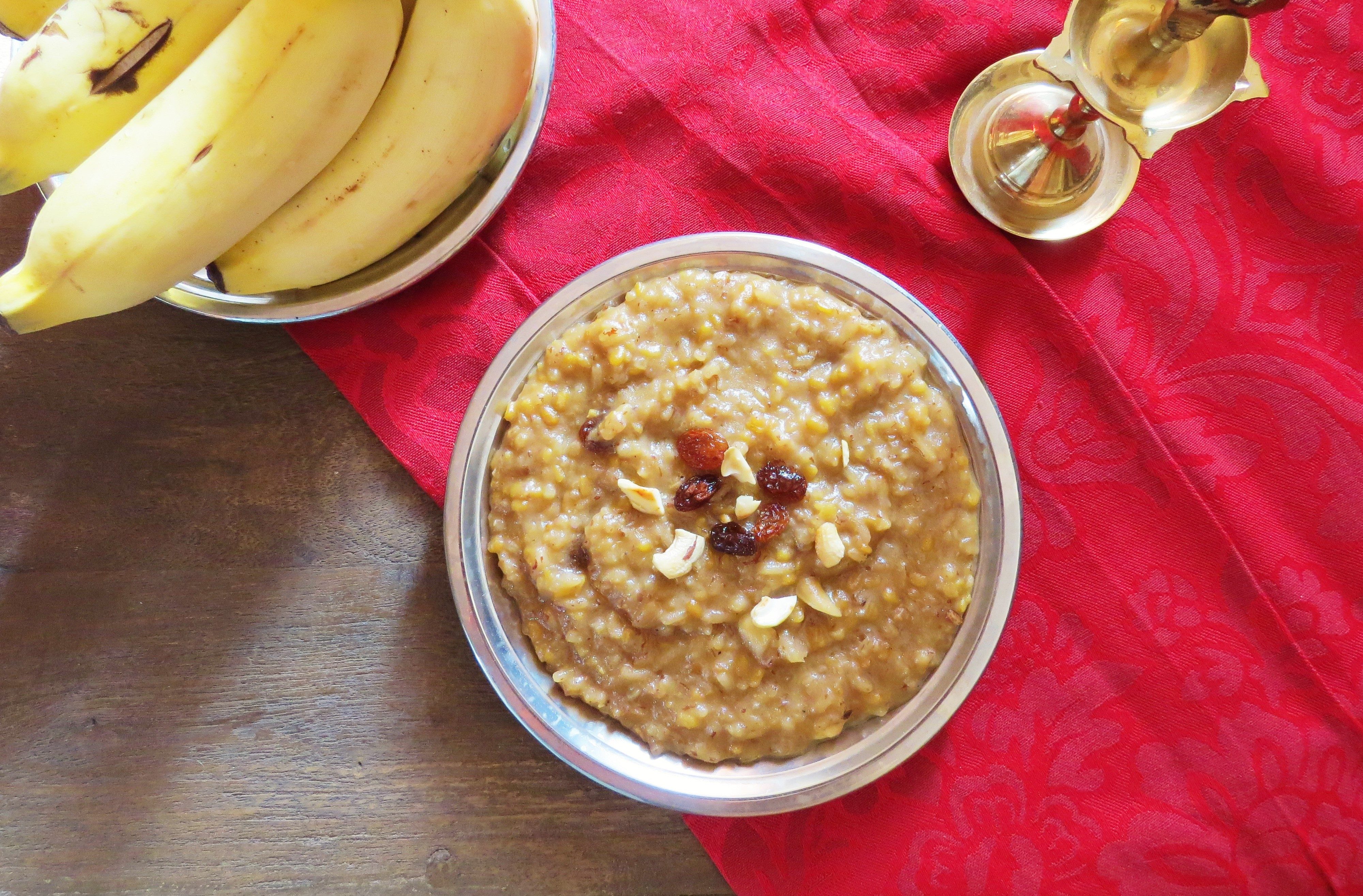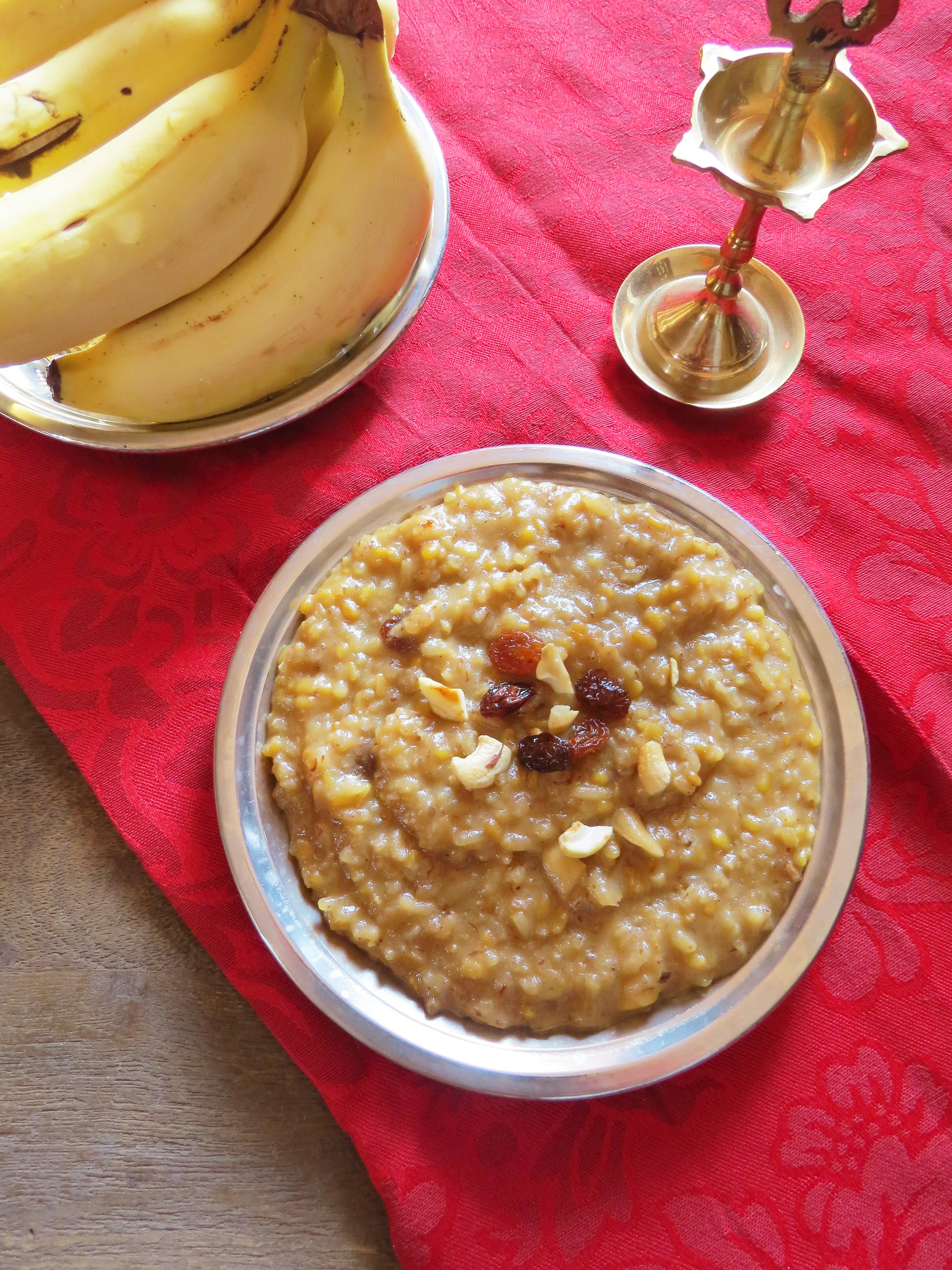In light of Thai Pongal this Friday I am sharing my sweet pongal or sakkarai pongal recipe. I actually jotted down the recipe as I prepared a small batch over the weekend. As I have mentioned before the way I learned to cooked Sri-Lankan cuisine was by trial and error — throwing things into a pot while using my hands as measuring tools. When I first moved out of my parents home and asked my mom for her pongal recipe, she didn’t have a written recipe to give me. Instead I had my mom on the phone instructing me through my first attempt at pongal. This will be my sixth year celebrating Thai Pongal out of my mom’s home and in between Thai Pongal, Tamil New Year, and Navaratri, I have gotten enough practice to make decent sweet pongal.
Thai Pongal is an ancient Tamil festival which dates back to the Sangam period. It falls on the first day of the first month, Thai, of the Tamil calendar and is often viewed as the equivalent of Thanksgiving in North America as we give thanks to the Sun for a bountiful harvest of crops. Although Pongal continues to be celebrated by Tamils all over the world, the festival is usually a multi-day celebration in the motherland as Thai Pongal is followed by Mattu Pongal. Mattu Pongal is a day devoted to the cattle that plough the fields so that crops can grow and to the dairy cows that provide milk to nourish our young. This multi-day festival commemorates the passing of the winter solstice and the beginning of the new harvest season. Pongal, a mixture of rice, milk and jaggery, is made early in the morning as the Sun rises and is then offered to the Sun. While in our homeland, Thai Pongal is an elaborate celebration consisting of many rituals such as pongal being cooked outdoors in clay pots decorated in mango leaves, Tamils living in foreign countries still celebrate and give thanks by making and eating pongal at home.
While making pongal on Thai pongal there are a few rituals to keep in mind. First off the home, especially the entry-way and kitchen must be thoroughly cleaned. Secondly you should not start making pongal by placing an empty pot on the stove. Instead the silver pot must be filled to the top with water and a tiny bit of milk. Once the water starts to boil and even spill over, the rice and moong dal can be added and some of the water can be removed. It is customary to grab a handful of the rice and moong dal mixture and go around the rim of the pot three times before throwing it in. The pongal or its ingredients must not be eaten before the pongal is offered to the Sun. Once the pongal is done, it is placed in a silver dish or banana leaf on a window (or a table near the window) in the direction of the rising sun. A few moments are then taken to say thanks and then the pongal is served to all family members. Some even leave pongal out for the birds.
Below is a very simple recipe for sweet pongal. The most important thing to remember about making pongal is to cook it on low-medium heat to prevent it from burning.
Sweet Pongal Recipe
Ingredients:
- 1 cup red raw rice
- 1/2 cup roasted Moong dal
- 4 cups water
- 1 cup whole milk
- 2 Tbsp cashews, broken
- 2 Tbsp raisins
- 1 and 1/4 cup dark jaggery (sakkarai)
- 12 sugar lumps (katkundu)
- 4 Tbsp ghee
- 5 cardamom pods
Instructions:
- In a pan roast raisins and cashews in a little bit of ghee until golden. Set aside.
- Rinse the rice and moong dal in cold running water and then let it soak in water for about half hour.
- Remove and discard the shells of the caradamom pods and then powder the insides. Set aside.
- Add water, rice, and moong dahl to a pot. Let it reach and boil and then cover and let it cook on medium-low heat.
- In the meantime cut the jaggery into small pieces and then immerse in warm milk. Let the jaggery dissolve before straining the jaggery syrup into another bowl.
- Once the rice and moong dahl is soft and no water remains, add the jaggery and bring to a boil. Let the whole thing simmer for a few minutes while stirring occasionally. The pongal should be semi-thick.
- Add the sugar cubes, ghee, and powdered cardamom.
- Once the sugar and ghee is melted, add the raisins and cashews. Turn off the heat.
NOTES:
- Soaking the rice and moong dal reduces cooking time.
- Dissolving and straining the jaggery prevents impurities that are sometimes found in it such as stones, from being ingested.
- When allowing the pongal time to thicken, keep in mind that it will thicken considerably as it cools.
- It is important to use good quality ghee for the best taste.
- If sugar is a health concern, reduce the amount of jaggery and sugar lumps used.
- Serve warm.
Do you prepare sweet pongal differently? If so, please share!






[…] recipe for jaggery pongal can be found here. I will try my best to update my blog with recipes for sundal and aval during this […]